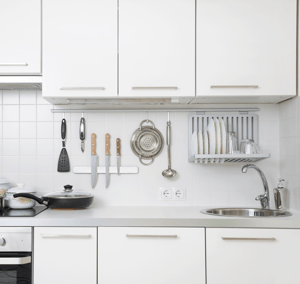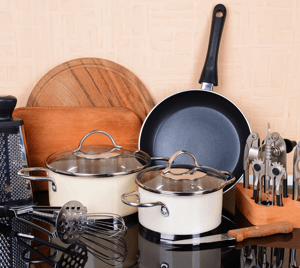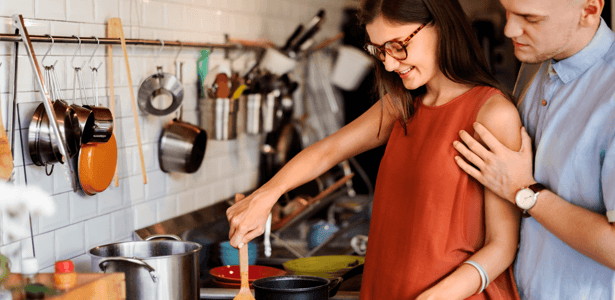There are so many considerations to make when buying your new home that it's easy to forget about all the little details, especially when it comes to things you'll need once you're moved in.
The last thing you want is to get so caught up in mortgage terms and finances that you move into a home lacking the basics.
We're here to help.
In many cultures, the kitchen is considered the beating heart of the home, so we'll start there. Whether you're finely crafting gourmet meals or having fun family time putting together snacks, the kitchen is easily one of the most important rooms of the house.
But to get the most out of your kitchen, it's important to have all the right tools and accessories. We've prepared this handy guide to make sure that your kitchen is a warm and inviting place where fantastic memories are made.
 Basic Utensils
Basic Utensils
Of course, you'll need glasses, plates, and silverware in order to enjoy a meal, but make sure you have at least one of all of the following in order to make cooking and preparing food simple and satisfying:
- Ladle. Look for a hooked/bent top to rest on the side of a pot and a deep enough bowl to comfortably ladle out soups and liquids.
- Tongs. Look for tongs with comfortable, non-slip handles, scalloped (curved) edges for better grip, and the ability for the tongs to be locked closed for easier storage.
- Metal spatula. Ideal for grilling or cooking on cast iron skillets. An angled edge makes it easier to slip under meat or other foods.
- Rubber spatula. Perfect for scraping bowls clean or stirring ingredients. The best models use a silicon tip that can be safely used around hot foods.
- Whisk. Look for a solid handle that won't get clogged with dough or food items. Thinner wires are perfect for softer foods like egg whites and cream.
- Slotted spoon. Make sure the handle is thick enough or insulated well so it won't get too hot to touch.
- Wooden spoon. Simple yet effective, wooden spoons never scratch delicate cookware and are very heat resistant.
- Potato masher. The best designs have a curved head so you can easily reach the corners of bowls and pots.
- Vegetable peeler. Look for one with a comfortable, no-slip grip that has a protective bar around the slicing edge. The newer Y-shaped peelers work better than old-fashioned swivel graters.
- Garlic press. Make sure it can be washed in the dishwasher for easy clean-up.
- Measuring cups. Look for ones with both metric and standard units.
- Measuring spoons. Oval-shaped spoons more easily fit into narrow openings like spice jars.
Note: If you're a parent looking to help your kids buy their first home or buying gifts for a first-time homeowner you know, the above list is a great way to make sure that the new kitchen is fully stocked and ready to enjoy!
Kitchen Knives
A kitchen wouldn't be very useful without some knives. Aspiring chefs may need a whole set of specialty knives, but make sure your kitchen has all the basic cutting essentials:
- Fillet knife. A long, thin blade is perfect for filleting fish, delicately slicing fruits and vegetables, and any other fine cutting work you'd want to do in the kitchen.
- Bread knife. Look for a comfortable handle and a long, serrated (with "teeth") blade.
- Chef's knife. This will be the main knife used for cooking. For most cooks, an 8-9 inch blade with a thick, comfortable grip is ideal.
- Shears. Looking like an over-sized pair of scissors, kitchen shears should have big blades but a finely tapered tip.
- Paring knife. With a short but sharp blade about 3-4 inches long, paring knives are good for dicing tough vegetables, coring fruit, and peeling the skin from fruits and vegetables.
- Cutting board. This can be the traditional wooden style or the newer silicone/plastic mats that are easier to clean.
 Manual Tools
Manual Tools
For easier food prep, don't forget to buy:
- Citrus press. Look for one big enough to handle grapefruit with a ridged grinding area.
- Corkscrew. Better to invest in a high quality, easy-to-use model than a cheap collapsible waiter's corkscrew with an attachment for opening bottles.
- Thermometer. Ensure it's designed for food and can handle high temperatures.
- Colander/Strainer. A perfect multi-use tool. Colanders designed for pasta should have a footing for improved stability and drainage.
- Salad spinner. Not only will this quickly dry lettuce and salad items, but it can double as a serving bowl.
- Grater. It's often best to have both a big grater for large items (like carrots, cabbage, etc.) and a fine grater for smaller, more delicate items (like lemon zest and parmesan cheese). Make sure the grater is easy to use and fits nicely in the hand.
- Kettle. Nothing cheers up the soul more than a hot drink on a cold day.
Electric Tools
These items are a great way to give cooks even more food preparation options:
- Timer. Whether you go digital or prefer an old-fashioned mechanical model, it's always a good idea to keep a timer in the kitchen.
- Can opener. The best models cut around the outside of the can to produce smooth edges and keep the lid from sinking into the can.
- Blender. Great for whipping up soups, smoothies, and a variety of drinks. Look for variable speeds, including an ice crushing mode.
- Hand mixer. Ideal for quickly blending and mixing a variety of food items.
This guide is just a basic list to get you started on stocking up your new kitchen.
As you continue to prepare foods in your kitchen, you'll figure out what tools and utensils you use the most and which ones you need to buy. As you acquire new items like dishcloths, spice racks, flour, sugar, tea, and coffee containers, and salt and pepper shakers, you can start to match the design to perfectly complement your kitchen décor.
Bon appétit!




